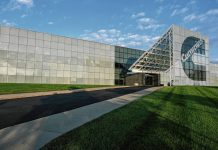
Mike Wolanin | The Republic Phyllis Viola Boyd, from left, director of Indy Parks and Recreation, Mark Jones, director of Columbus Parks and Recreation, Sara Zewde, founding principal of Studio Zewde, and Laura Garrett, director of partnerships for Landmark Columbus, take part in an Exhibit Columbus Miller Prize winner panel discussion about Studio Zewde’s installation Echoes of the Hill at Helen Haddad Hall in Columbus, Ind., Saturday, Nov. 18, 2023.
Architect Paul Benigno of Chicago traveled to Columbus Saturday to see the 13 Exhibit Columbus architectural installations — and also to listen to the last of the four free Miller Prize Conversations with the event’s top designers working all over the globe.
Exhibit Columbus lasts through Nov. 26 with the theme “Public By Design.”
‘To me, these installations are like welcome mats for people to inhabit,” Benigno said at the end of the 90-minute panel discussion in front of 33 people at Helen Haddad Hall on Franklin Street in downtown Columbus.
That creative description seems as apt as anything for landscape designer Sara Zewde’s bamboo work “Echoes of the Hill,” a Mill Race Park piece that some have described as looking like an overturned ship’s ribbing.
New York City’s Zewde, part of a four-member panel at this last conversation, warmly chuckled afterward at that comparison. But she repeated what she mentioned as early as a year ago before her team built the piece facing the park’s hill adjacent to the Custer Nugent Amphitheater: that her creation, painted in the traditional “Columbus red,” as she called it, was meant to be in seeming conversation with a facing hill designed by noted landscape architect Michael Van Valkenburgh.
The hill is symbolic of indigenous people’s burial mounds.
But Zewde acknowledged that she never really planned on bamboo for her piece that children have since climbed on and others have sat under.
I was thinking about this form originally as something made out of metal,” Zewde said. ” I think I was obsessed with the precision of the form. (But) we had to pivot just because of feasibility and this thing being temporary.”
The three-month Exhibit Columbus exhibition highlights the city’s Modernist legacy and nudges it progressively into the future every other year by having designers build new pieces meant to be spinoffs of a sort of the town’s current structures and landscapes. Every other year since 2017, the exhibition has built upon Columbus’ global reputation as a Modernist mecca.
It is funded by grants and private donations rather than tax dollars. And it has generated international publicity of such magnitude that local city and tourism leaders have said that paid advertising couldn’t quite secure such a wide range of attention.
Saturday’s panel also included Exhibit Columbus community curator Mark Jones, director of Columbus Parks and Recreation, who worked with Zewde to help make “Echoes of the Hill” a reality; Phyllis Boyd, director of Indy Parks and Recreation; and Laura Garrett, director of partnerships for the nonprofit Landmark Columbus Foundation, the umbrella agency over Exhibit Columbus.
Garrett served as panel moderator.
Zewde acknowledged after the event that she wanted Mill Race Park landscape architect Van Valkenburgh to see her installation as complementary to his extensive project in 1993 to covert the roughly 90-acre downtown space from an eyesore once known as Death Valley to something beautiful and useful to all. His opinion was important to Zewde especially because she refers to him as “the greatest living landscape architect” in the nation.
Van Valkenburgh was her professor in graduate school. He also was originally scheduled to be on Saturday’s panel before a change of plans.
“I wanted to make sure that this (installation) was in the spirit of what his intentions were for the park,” she said. “He loved it. He had a very positive review of it.”
Zewde’s latest project involves beautifying an added 200 acres of Cuyahoga Valley National Park between Cleveland and Akron, Ohio. She mentioned that, as a minority architect, she feels a passion to be a tool to draw disenfranchised people back to the space.
“Black people from Cleveland and Akron used to use it as a place to escape the Klan and the racism in the city,” Zewde said after the meeting. “And then when it became a national park, they actually felt no longer welcome to do that.
“And so now this new, next chapter of the park is a chance to bring them back in or invite them back in.”
















